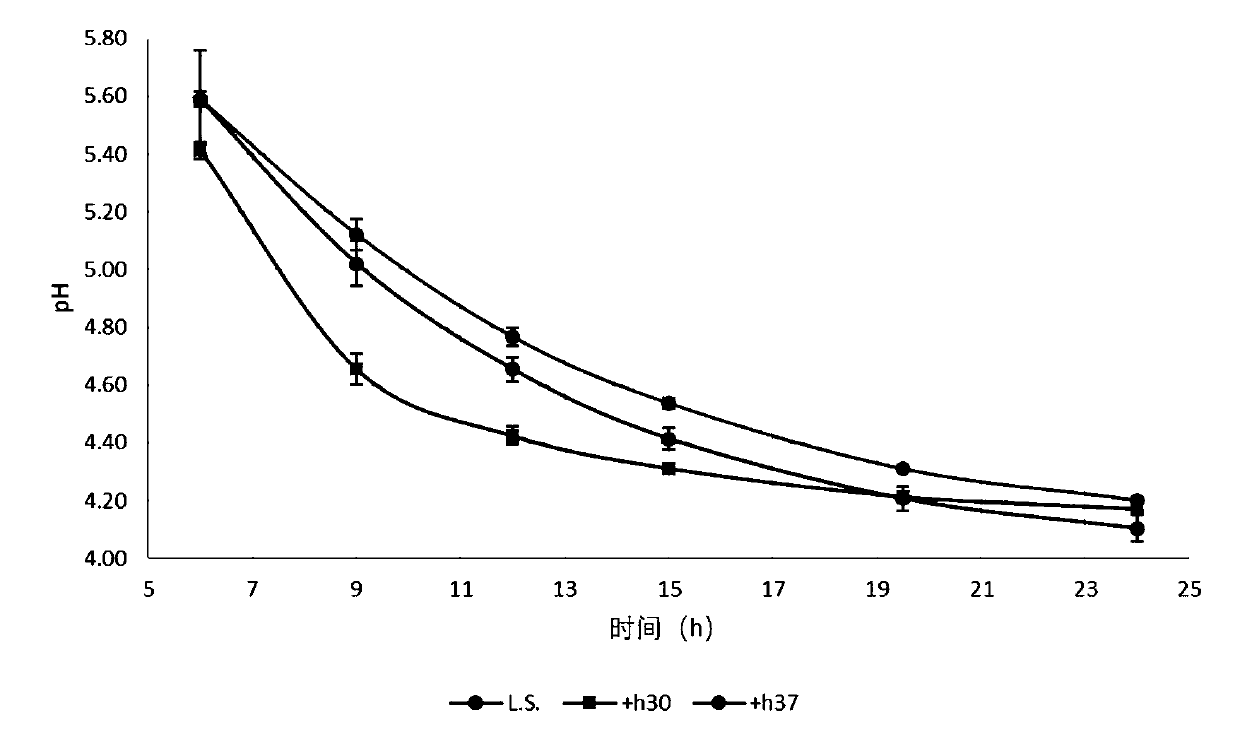A kind of Lactococcus lactis and application thereof
A technology of Lactococcus lactis and Lactobacillus, applied in Lactococcus lactis and its application fields, can solve the problems of incomplete production process and industrial production process, achieve good adaptability, increase fermentation rate, and standardize the process
- Summary
- Abstract
- Description
- Claims
- Application Information
AI Technical Summary
Problems solved by technology
Method used
Image
Examples
Embodiment 1
[0039] Example 1: Isolation and strain identification of Lactococcus lactis Lla-lab2014h30
[0040] 1. Isolation of strains
[0041] (1) Configure M17 separation medium, pour it into the plate, dilute the kumiss milk taken from the herdsman’s house in a gradient, draw the three-section line on the plate, and place it at 30°C and 37°C for culture respectively, and the culture time is 24-48h;
[0042] (2) Select suitable bacterial colonies in step (1) to carry out plate streak separation;
[0043] (3) Perform microscopic examination on the colonies in step (2). If there are many miscellaneous bacteria, continue to streak and separate. If there are basically no miscellaneous bacteria, you can stop streaking on the plate.
[0044] 2. Identification of strains
[0045] The 16S rDNA sequence of the bacterium colony isolated in step (3) is shown in SEQ ID No.1, carries out sequence alignment in NCBI, finally determines that the isolated bacterial strain belongs to Lactococcus lacti...
Embodiment 2
[0053] Embodiment 2: the preparation of yogurt starter
[0054]According to the colony growth curves of Lactobacillus bulgaricus, Streptococcus thermophilus, Lactococcus lactis (Lactococcus lactis) Lla-lab2014h30, Leuconostoc subsp. Among them, 1.5% glucose was added to Leuconostoc skimmed milk medium, and each strain was subcultured and activated for 3 generations; Lactobacillus bulgaricus and Streptococcus thermophilus were cultured for 12 hours each; Lactococcus lactis Lla-lab2014h30 was cultured for 12 hours each; Leuconostoc Subsp. enterica was cultured for 16 hours per generation; Kluyves marxe was cultured for 24 hours per generation and activated for three generations. Draw 0.5ml of skim milk medium containing Lactobacillus bulgaricus, 0.5ml of skim milk medium containing Streptococcus thermophilus, 1ml of skim milk medium containing Lactococcus lactis, and 1ml of skim milk medium containing Leuconostoc enterococcus subsp. , containing 1ml of saccharomyces skimmed mil...
Embodiment 3
[0055] Embodiment 3: the preparation of sour kumiss
[0056] (1) Rehydrate the horse milk powder, stir and dissolve it with drinking water equivalent to 9 times the weight of the horse milk powder;
[0057] (2) Disperse the incompletely dissolved rehydrated mare's milk obtained in step (1) at 8000r / min for 1min;
[0058] (3) The dispersed and rehydrated mare's milk obtained in step (2) was hydrated for 30 minutes in a water bath at 45°C;
[0059] (4) Sterilize the rehydrated mare's milk in step (3) at 65°C for 30 minutes;
[0060] (5) Add fermented bacterial strains in step (4) sterilized rehydrated mare's milk, its total inoculation amount is 5% of milk base volume, and each bacterial strain proportioning is Lactobacillus bulgaricus: Streptococcus thermophilus: Lactococcus lactis Lla- lab2014h30 is 0.5:0.5:1.
[0061] (6) Ferment the mare’s milk to be fermented in step (5) at a constant temperature of 32° C. for 24 hours, and shake it in a constant temperature water bath a...
PUM
 Login to View More
Login to View More Abstract
Description
Claims
Application Information
 Login to View More
Login to View More - R&D
- Intellectual Property
- Life Sciences
- Materials
- Tech Scout
- Unparalleled Data Quality
- Higher Quality Content
- 60% Fewer Hallucinations
Browse by: Latest US Patents, China's latest patents, Technical Efficacy Thesaurus, Application Domain, Technology Topic, Popular Technical Reports.
© 2025 PatSnap. All rights reserved.Legal|Privacy policy|Modern Slavery Act Transparency Statement|Sitemap|About US| Contact US: help@patsnap.com



